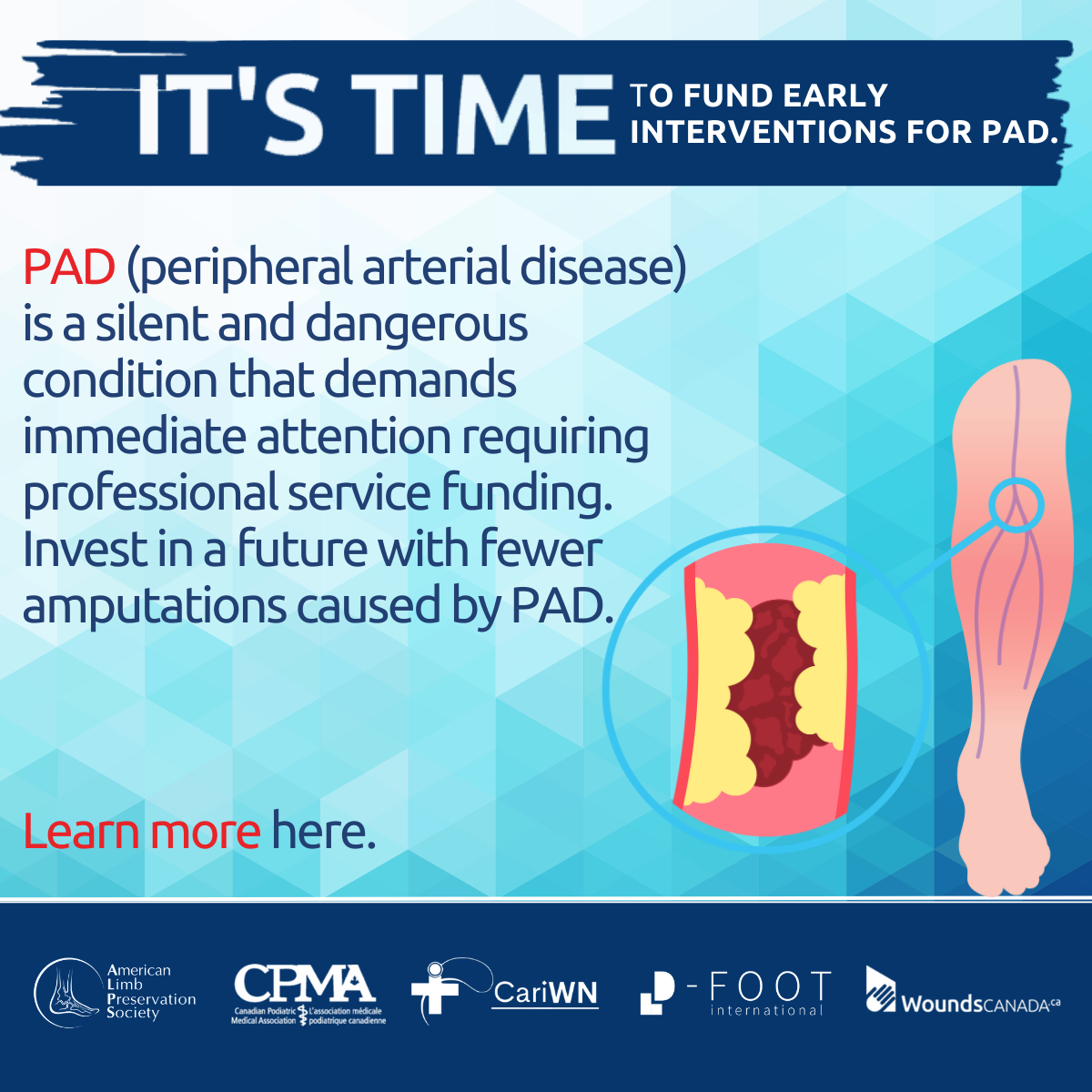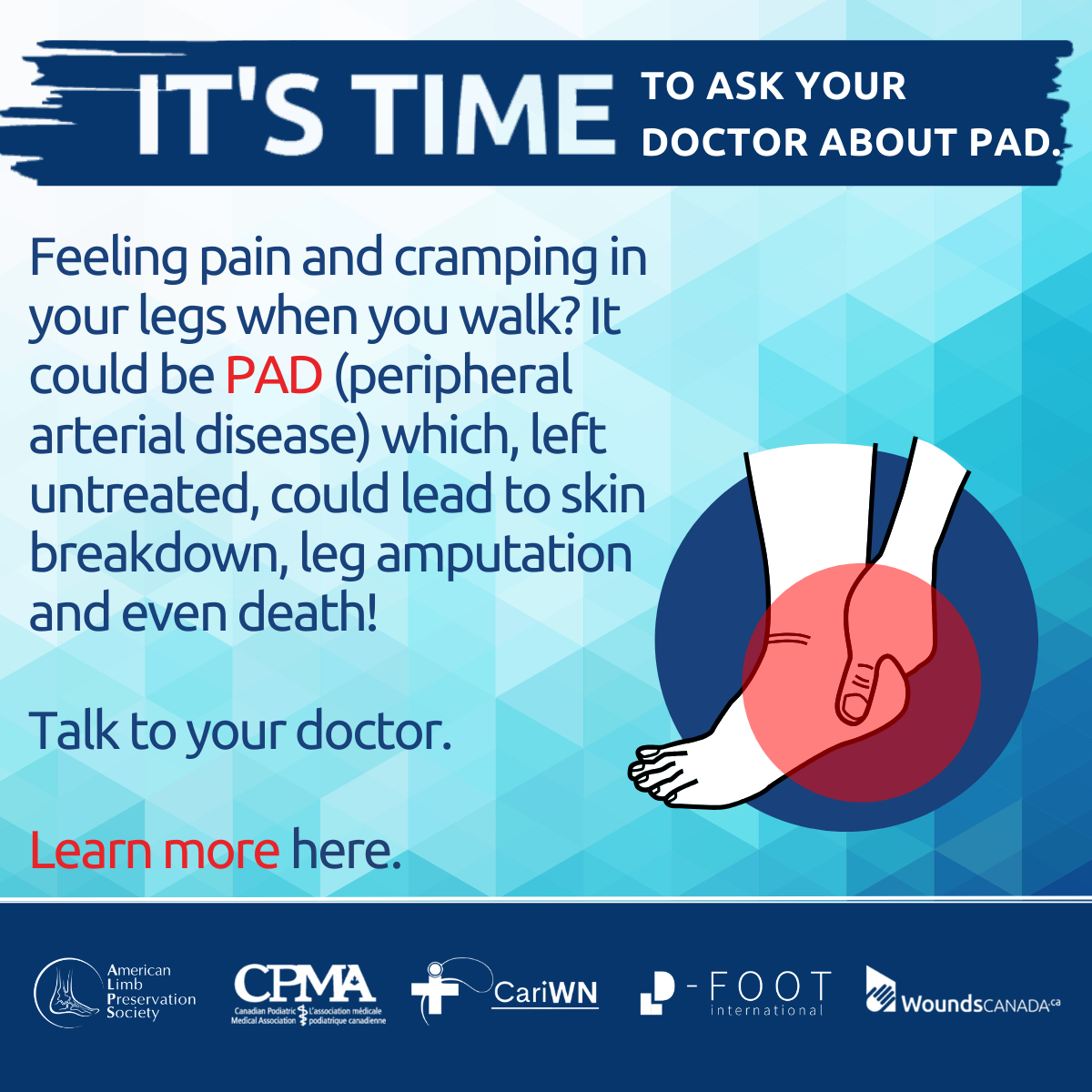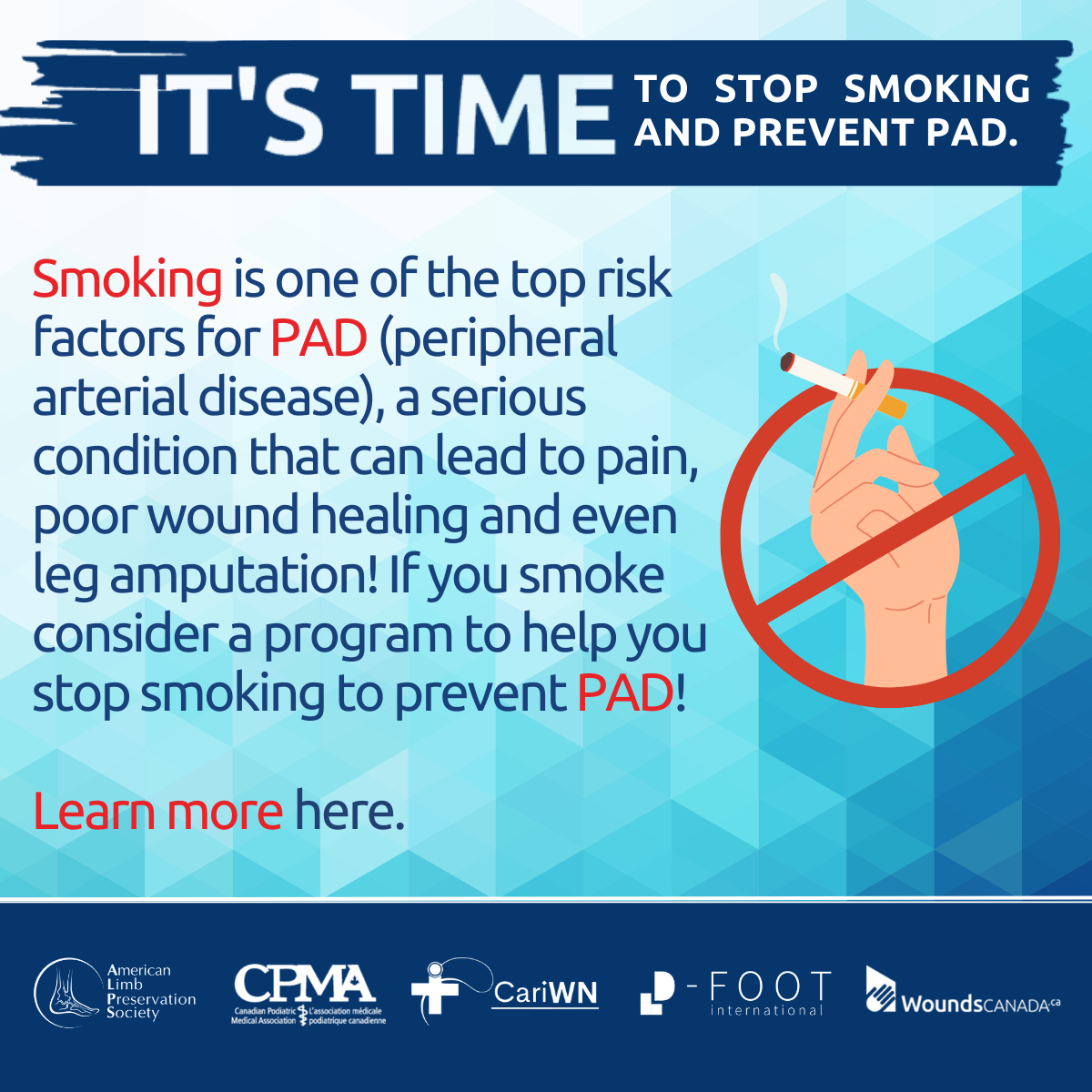



September is Peripheral Arterial Disease (PAD) Awareness Month
"If You Think It’s Just Leg Pain…Think Again”
At Wounds Canada, we believe that increasing awareness of peripheral arterial disease (PAD) is necessary to reduce the negative impacts of this under-recognized condition on Canadians. IT’S TIME to recognize risk factors and take early, effective action to reduce the incidence of arterial ulcers and mortality rates caused by PAD.
What is PAD?
Peripheral Arterial Disease (PAD) is a condition that involves the narrowing of arteries in a person’s extremities (arms and legs). While PAD can occur in any blood vessel, it is more commonly found in the legs than in the arms.
PAD can result in such poor blood flow to the limb that it leads to:
- Chronic pain (pain that doesn’t stop)
- Tissue breakdown (wounds)
- Tissue death (also known as gangrene or necrosis, a permanent loss of skin and other tissues)
- Amputation of the affected limb
- Death
Who is most at risk for PAD?
- Individuals over 70
- Individuals over 50 who have
- high blood pressure (hypertension)
- diabetes
- a history of smoking
- high cholesterol
- a history of vascular disease, heart attack or stroke
- People of African or Hispanic descent
PAD Facts
- It is estimated that 1.5 million Canadians over the age of 40 are living with PAD.
- Early detection and treatment can help slow, stop or reverse the progression of PAD.
- People with diabetes are two to four times more likely to develop PAD.
- A high number of individuals with PAD are of lower socioeconomic status and face barriers to accessing treatment.
What are the symptoms?
-
Muscle cramps in the legs during physical activity
- Pain in the legs or feet that disrupts sleep
- Slow or poor healing of wounds on the toes, feet or legs
- Discoloration or reduced temperature in one leg compared with the other
- Poor nail growth and less or no hair growth on the toes and legs
What can I do if I am at risk for or have symptoms of PAD?
Talk to your doctor. The sooner you get a proper diagnosis, the sooner treatment for PAD can begin. This is important for preventing complications, such as the development of leg ulcers, and improving your long-term outcomes. Your doctor will likely start out by asking you questions about your general health, lifestyle and family history, discussing any symptoms you have and performing some simple physical tests. Your doctor may also order some diagnostic tests and/or refer you to a specialist for further investigation and treatment.
If you have PAD or are at risk for it, your health-care team will work with you to create a care plan that may involve lifestyle changes (such as quitting smoking and/or getting more exercise), medications (for example, for controlling pain and/or to treat issues such as high blood pressure, blood glucose or cholesterol levels) and potentially surgery. Together these actions may help to prevent the PAD from getting worse, reduce the risk of unnecessary limb loss through amputation and preserve your quality of life.
What should my health-care system provide?
Effective recognition and early, effective interventions require that a number of elements be in place and available to patients and health-care providers. Included among them are:
- Ongoing education and training for health-care providers regarding PAD-related risk factors, prevention activities and management strategies, as well as what resources are available for their patients in the community.
- An environment focused on skin health and risk-based, early intervention.
- Adequate funding to support PAD-related prevention and management activities.
- Lower-limb centres where a range of expert practitioners can provide person-focused care, either in a physical location or virtually. This requires financial and policy support.
- Community supports for sustainable management that are easily accessible for patients with PAD and their families.
PAD is a silent and dangerous condition that demands immediate attention. By raising awareness, advocating for early detection of risk factors and promoting proactive care, we can prevent unnecessary limb loss and improve the quality of life for millions.
Click play to watch an insightful message on PAD prevention and intervention from Dr. David Armstrong, representing the American Limb Preservation Society (ALPS), our valued awareness partner and member of the Limb Preservation Alliance.
Wounds Canada Resources: Download for free!
What should my health-care system provide?
For Patients
Brochure: If you think it’s JUST leg pain . . . think again.
DIY Series: Arterial Foot or Leg Ulcer
For Health-care Providers
Brochure: Get the facts on peripheral arterial disease (PAD).
Best Practice Recommendations for the Prevention and Management of Arterial Ulcers
For Health Decision Makers
Pathway for Preventing and Managing Vascular Wounds
Diabetes in Canada: #End Amputations
Wounds in Canada: The Hidden Epidemic
- Keynote: A Passion for Saving Limbs: Lessons Learned from a Career in Amputation Prevention
- Challenges and Opportunities to Limb Preservation in Rural and Remote Communities
THE 2024 PAD AWARENESS CAMPAIGN
Get involved! Raise awareness about PAD awareness and prevention by:
- Joining the Conversation: Engage on social media to learn more about PAD and spread the word. Follow Wounds Canada’s awareness campaigns on Twitter, Instagram, Facebook and LinkedIn. Use the hashtags #LimbPreservationAlliance, #ActAgainstAmputation, #PADAwareness, #PeripheralArterialDisease, #ProtectSkin, #EndWounds and #ActAgainstAmputation.
- Promoting Prevention: Discuss risk factors and available support in your community to increase awareness and improve the lives of those at risk of PAD and their families.
- Sharing Your Experience: If you or a loved one is living with PAD, use your voice to help raise awareness or share your experience with our team.
- Donating: You can make a charitable donation to Wounds Canada to support research and provide essential resources to those affected by PAD. Your generosity has the power to change lives!
An important message focusing on early diagnosis from Dr. Howard Green, president of the Canadian Podiatric Medical Association (CPMA).
The Limb Preservation Alliance
In 2023 Wounds Canada joined forces with the American Limb Preservation Society, the Canadian Podiatric Medical Association and D-Foot International to establish an alliance to address the global challenge of PAD and to promote and advocate for limb preservation. The alliance aligns with Wounds Canada’s mission to build a healthier Canada by advancing skin health and excellence in wound management.

